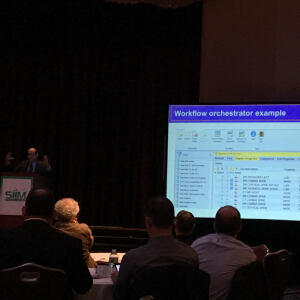By Lisa Chamoff and John R. Fischer
While artificial intelligence was the main buzzword at this week’s SIIM-NYMIIS Regional Meeting in Manhattan, there was also a less sexy, but still important, focus on making sure imaging departments are well organized with workflow orchestration and protocol standardization, and a look at enterprise imaging.
Dr. David Hirschorn, chief of informatics for the imaging service line at Northwell Health in New York, and the conference co-chair, extolled the virtues of a workflow orchestrator and its role in maximizing throughput and developing subspecialty expertise.



Ad Statistics
Times Displayed: 63870
Times Visited: 2092 Ampronix, a Top Master Distributor for Sony Medical, provides Sales, Service & Exchanges for Sony Surgical Displays, Printers, & More. Rely on Us for Expert Support Tailored to Your Needs. Email info@ampronix.com or Call 949-273-8000 for Premier Pricing.
This kind of organization is important for facilities looking to become accredited stroke centers and honor service agreements, and is critical in the era of consolidation, with radiology groups growing bigger and more complex, Hirschorn said.
“Radiology has to be able to respond and get the scan done, get the reading communicated in a timely fashion, document it, and prove that it got done every time, not just most of the time,” Hirschorn told the radiologists and those in the health care industry gathered at the Marriott Marquis in Times Square for the meeting. “It needs a workflow engine that’s going to be able to track that, be a watchdog, and be sure that that happens.”
A workflow orchestrator can also help keep track of radiologists’ schedules and make sure exams are read in a timely fashion, even when someone is out sick or on vacation, Hirschorn said. They can also ensure that exams are labeled with consistent names and descriptions.
Workflow organization is available with PACS and RIS systems, but that is not those systems’ core competency, Hirschorn said. Radiologists can also use the EMR, or purchase an independent workflow orchestrator.
“At least it’s in the business of doing it,” Hirschorn said. “That’s its job.”
Ann Scherzinger, a professor at the University of Colorado and a conference co-chair, spoke about the importance of protocol standardization, particularly when it comes to providing lower-cost, quality care to patients.
“A prerequisite to actually integrating these services into service lines is to standardize the services somehow,” Scherzinger said. “So it wouldn’t matter which institution the patient was sent to within our many hospitals, they would get same service and the same value.”
Scherzinger’s health system went through the process of standardizing protocols, including preparation for exams and standardizing study descriptions, and shared the best practices; which included creating a team for protocol review led by a process improvement specialist and involving key executives and stakeholders, including the radiologists, radiation technologists, medical physicists and the IT department.

